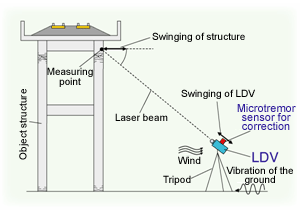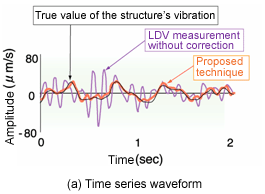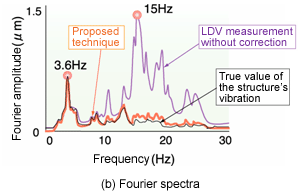|
The technique of structure inspection using the structure's natural frequency (obtained from vibration measurement) is applicable not only to normal soundness inspection but also to damage inspection after an earthquake and confirmation of safety after restoration work. However, the installation of sensors and connection/disconnection of cables to measure structural vibration for this purpose is very time-consuming. In the case of viaducts and bridges, sensors must be installed in high places, and secondary damage is anticipated in post-earthquake inspections in particular.
To raise the efficiency of vibration measurement and ensure the safety of inspection work, the RTRI has developed a non-contact microtremor measuring technique (Fig. 1) using a laser Doppler velocity meter (LDV) that makes it possible to obtain the natural frequency and vibration modes without exciting structures or installing sensors on them.
When structural microtremors (of approximately ƒÊm in amplitude) are measured outdoors with an LDV, vibration can occur due to ground vibration and wind, making correct measurement of structural microtremors impossible. The RTRI has therefore developed a technique whereby a microtremor sensor is incorporated into the LDV to measure its vibration, enabling removal of the noise contained in the LDV measurements (Fig. 2). As a result, it is now possible to correctly measure microtremors in viaducts and other structures from a point about 5 to 50m away to determine their natural frequency and vibration modes.

Fig. 1 Non-contact measurement of structural microtremors
 |  |
| Fig. 2 Effect of the technique to remove noise from LDV measurements |
HOME > Major Results of Research and Development in Fiscal 2004 > I Safety/Reliability

RTRI HOME
Copyright(c) 2005 Railway Technical Research Institute,Tokyo Japan, All rights reserved.
|


